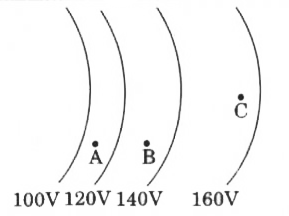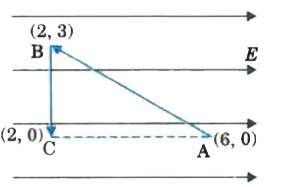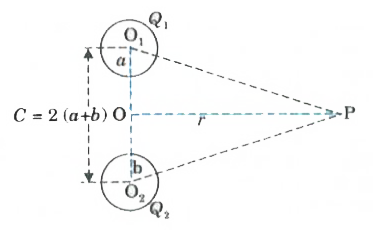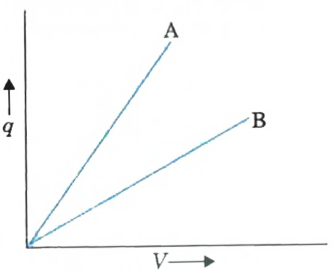Complete Solutions to Revision Exercises (Short Answer Questions) of chapter ELECTROSTATIC POTENTIAL AND CAPACITANCE of Class 12 book with complete answers and questions
| Class 12 | PHYSICS |
| Chapter | ELECTROSTATIC POTENTIAL AND CAPACITANCE |
| MODERN PUBLICATION | Revision Exercises (Short Answer Questions) |
| Number Of Questions | 38 |
| Academic Year | 2023-24 |
Derive an expression for the electric potential due to a point charge.
View SolutionGraphically represent the variation of electric potential and electric field due to point charge with respect to the distance from the point charge.
View SolutionTwo identical positively charged particles P and Q are placed between two parallel paltes having a potential difference of V volts between them as shown in the figure. Which of them will experience larger force?

View SolutionThe given figure shows equipotential surfaces is an electric field. Three points A, B and C are also shown.
Which among the three points have:
(i) the maximum magnitude of electric field intensity?
(ii) the minimum magnitude of electric field intensity?

View SolutionDefine electric dipole. Show that the electric field is the negative gradient of its potential.
View SolutionThe electric potential at a point P due to two charges in fig (a) is `V_(1)` and in fig (b) is `V_(2)`. Consider the given object to be a ring. What is the relation between `V_(1) and V_(2)`? Explain your answer.

View SolutionDeduce an expression for the electric potential due to an electric dipole at any point on its axis. Mention one contrasting feature of electric potential of a dipole at a point as compared to that due to a single charge.
View SolutionDerive an expression for the potential energy of an electric dipole placed in a uniform electric field.
View SolutionWhat are equipotential surfaces? Give their properties.
View SolutionDraw the equipotential surfaces due to an electric dipole. Locate the points where the potential due to the dipole is zero.
View SolutionWork done in moving a positive charge on an equipotential surafce is
View Solution(i) On what factors does the capacitance of a capacitor depend?
(ii) Two capacitors of capacitances `20muF` and `60muF` are connected in series. If the potential difference between the two eneds of the combination is 40 volt, calculate the terminal potential difference of each capacitor.
View SolutionA test charge q is moved without acceleration from A to C along the path form A to B and then from B to C in electric field E as shown in the figure.

(i) Calculate the potential difference between A and C.
(ii) At which point (of the two) is the electric potential more and why?
View SolutionObtain the expression for the energy stored in a parallel plate capacitor of capacitance C charged to a potential V.
View SolutionA charge Q is distributed over two concentric hollow spheres of radii r and `R (gt r)` such that the surface charge densities are equal. Find the potential at the common centre.
View SolutionAt what position of an electric dipole placed in an electrostatic field the potential energy is minimum and why?
View SolutionFind the potential energy associated with a charge q if it were present at the point P with respect to the set-up of two charged spheres arranged as shown. Here O is the mid-point of the line `O_(1)O_(2)`.

View SolutionWhy should electrostatic field be zero inside a conductor ?
View SolutionShow that the electric field at the surface of a charged conductor is proportional to the surface charge density.
View SolutionHow does a non-polar dielectric develop a net dipole moment when placed in electric field?
View SolutionWhat will be the work done in taking a point charge from a point X to Y on te circumference of the given circle? Explain.

View SolutionWhat is the relation between dielectric constant and electric susceptibility ?
View SolutionBriefly explain the principle of a capacitor. Derive an expression for the capacitance of a parallel plate capacitor, whose plates are separated by a dielectric medium.
View SolutionNet charge on a capacitor is always zero, then what does a capacitor store? Explain.
View SolutionIn what form of field, is the energy of a capacitor stored? Derive an expression for energy of a parallel plate capacitor.
View SolutionExplain what happens to the capacitance of a capacitor when charge q on it is doubled.
View SolutionDerive an expression for energy density of a parallel plate capacitor.
View Solution(a) Derive an expression for energy density of a parallel plate capacitor.
(b) Radius of a spherical conductor is 9 cm. `A+4muC` charge is given to it. Calculate the capacitance of conductor.
View SolutionTwo charges of +5nC and -2nC are placed at points (5cm, 0, 0) and (23cm, 0, 0) in a region of space where there is no other external electric field. Calculate potential energy of this charge system.
View SolutionTwo capacitors `C_(1) and C_(2)` have the same separation between the plates but the plate area of `C_(2)` is twice that of `C_(1)`. The given graph shows the variation of q with V. Which of the two lines in the graph represents `C_(1)` and why?

View SolutionCan we give any desired charge to a capacitor?
View SolutionHow will the capacitance of a metal sphere change if its volume is doubled?
View SolutionA parallel plate capacitor each with plate area A and separation ‘d’ is charged to a potential difference V. The battery used to charge it is then disconnected. A dielectric slab of thickness d and dielectric constant K is now placed between the plates. What change if any, will take place in
(i) charge on the plates
(ii) electric field intensity between the plates,
(iii) capacitance of the capacitor
Justify your answer in each case
View SolutionA parallel plate capacitor of capacitance C is charged to a potential V. It is then connected to another uncharged capacitor having the same capacitance. Find out the ratio of the energy stored in the combined system to that stored initially in the single capacitor.
View SolutionCalculate the effective capacitance between a and b from the figure given below:
`C_(1)=C_(3)=100muF, C_(2)=C_(4)=200muF`.

View SolutionTwo parallel plate capacitors X and Y have the same area of plates and same separation between them.
X has air between the plates while Y contains a dielectric medium of `e_(r ) = 4`

(i) Calculate capacitance of each capacitor if equivalent capacitance of the combination is `4mu_(F)`
(ii) Calculate the potential difference between the plates of X and Y
(iii) Estimate the ratio of electrostatic energy stored in X and Y .
View SolutionWhy does current in a steady state not flow in a capacitor connected across a battery? However momentary current does flow during charging or discharging of the capacitor. Explain.
View SolutionWhen a dielectric is introduced between the plates of a charged parallel plate capacitor, which one of the following will not change?
View Solution
Revision Exercises (Short Answer Questions) questions and complete solutions for chapter ELECTROSTATIC POTENTIAL AND CAPACITANCE of MODERN PUBLISHERS PHYSICS (HINGLISH) of Class 12
All Exercises from MODERN PUBLICATION Class 12 PHYSICS ELECTROSTATIC POTENTIAL AND CAPACITANCE
- Chapter Practice Test
- Competition file (ASSERTION REASON TYPE QUESTIONS)
- Competition file (INTEGER TYPE QUESTIONS)
- Competition file (MATCHING TYPE QUESTIONS)
- Competition file (MATRIX TYPE QUESTIONS)
- Competition file (MULTIPLE CHOICE QUESTIONS based on a given passage/comprehension)
- Competition file (NCERT Exemplar Problems: Multiple Choice Questions Type-I)
- Competition file (NCERT Exemplar Problems: Multiple Choice Questions Type-II)
- Conceptual Questions
- Higher Order Thinking Skills & Advanced Level (QUESTIONS WITH ANSWERS)
- NCERT FILE Solved (Additional Exercises)
- NCERT FILE Solved (Additional Exercises) (Answer carefully)
- NCERT FILE Solved (Additional Exercises) (Answer the following)
- NCERT FILE Solved (Exemplar Problems) (Short Answer Type Questions)
- NCERT FILE Solved (Exemplar Problems) (Very Short Answer Type Questions)
- NCERT FILE Solved (Textbook Exercise)
- PRACTICE PROBLEMS 1
- PRACTICE PROBLEMS 2
- PRACTICE PROBLEMS 3
- PRACTICE PROBLEMS 4
- PRACTICE PROBLEMS 5
- Revision Exercises (Additional Questions)
- Revision Exercises (Fill in the Blanks)
- Revision Exercises (Long Answer Questions)
- Revision Exercises (Numerical Problems)
- Revision Exercises (Short Answer Questions)
- Revision Exercises (Very Short Answer Questions)
- SOLVED EXAMPLES
- Tough & Tricky PROBLEMS